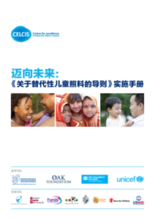This handbook (in Mandarin), Moving Forward: Implementation of the ‘Guidelines for the Alternative Care of Children,’ was developed by CELSIS under an initiative of the Working Group on Children without Parental Care of the NGO Group for the Convention on the Rights of the Child and the project’s Steering Committee which included representatives from ISS, SOS Children’s Villages International, Family for Every Child, ATD Fourth World, Better Care Network, RELAF, and UNICEF.
It is designed as a tool for legislators, policy-makers, and all professionals and care providers to support the implementation of the Guidelines for the Alternative Care of Children, endorsed by the United Nations General Assembly in 2009. By making a strong connection between national policy, direct practice, and the Guidelines themselves, the handbook emphasizes that children must never be placed in alternative care unnecessarily, and where out-of-home care must be provided, it should be appropriate to each child’s specific needs, circumstances, and best interests.
The handbook is organized around ‘clusters’ of provisions that follow the structure of the Guidelines and is developed with three main sections and standpoints in mind, Context, Implications, and Examples. It explains the key thrusts of theGuidelines, outlines the kind of policy responses required, and describes ‘promising’ examples of efforts already made to apply them in diverse communities, countries, regions and cultures. It provides guidance on the practical policy and practice implications of implementing the ‘Necessity Principle,’ and the ‘Suitability Principle’ that are at the core of the Guidelines, and on how to close the gap between policy intention and reality.
For each topic, at least two ‘Promising Practice’ examples are drawn from countries in all regions of the world. These examples were submitted by experts and NGOs or identified by the project’s own research. They link the Guidelines and the handbook to work that is already happening on the ground. An appendix is provided that includes further resources such as the full text of the Guidelines, key resources used in developing the handbook, international instruments and guidelines, commentaries on international guidelines, literature on alternative care, and websites of major children’s rights organizations and networks.
The handbook was field tested in Argentina (through RELAF) and Malawi (through BCN-Malawi) and went through a rigorous and academic literature review, drawing from a range of resources such as reports and studies on alternative care in a global context, international documents, and diverse responses to the consultation process.
©ISS, Oak Foundation, SOS Children's Villages International, and UNICEF (funders); ATD Fourth World, BCN, Family for Every Child, RELAF, Save the Children, and USAID (partners)

